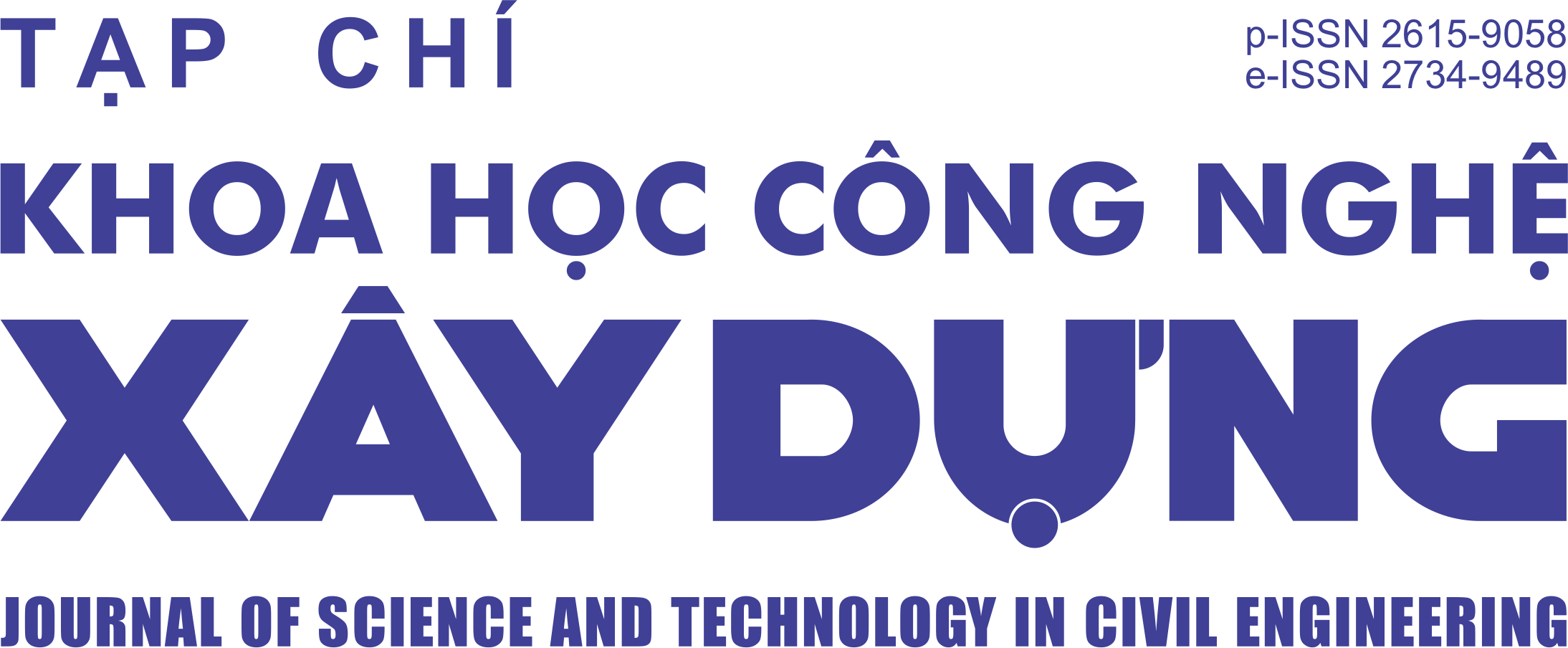Study on using maximum amount of fly ash in producing ultra-high performance concrete
Abstract
In the present study, the synergic effects of cementitious materials in the ternary binder containing cement, silica fume, fly ash on the workability and compressive strength were evaluated by using the D-optimal design of Design-Expert 7. The ternary binder composed of 65 vol.-% cement, 15 vol.-% SF and 20 vol.-% FA at the W/Fv ratio of 0.50 is the optimum mixture proportions for the highest compressive strength of the UHPC. To produce the sustainable UHPC, high-volume fly ash ultra high performance concrete with a good flowability and 28-d compressive strength over 130 MPa can be produced with fly ash content up to 30 vol.-% in the binder.
Article history: Received 21 March 2018, Revised 06 April 2018, Accepted 27 April 2018
Downloads
References
[2] Schmidt, M. (2012). Sustainable building with ultra-high-performance concrete (UHPC)–Coordinated research program in Germany. In Proceedings of Hipermat 2012 3rd International Symposium on UHPC and Nanotechnology for High Performance Construction Materials, Kassel University Press, Kassel, Germany, 17–25.
[3] Schmidt, M. and Fehling, E. (2005). Ultra-high-performance concrete: research, development and application in Europe. In The 7th International Symposium on the Utilization of High-Strength- and High-Performance-Concrete, ACI Washington, 51–78.
[4] Schmidt, M. (2007). Von der Nanotechnologie zum Ultra-Hochfesten Beton. In The 16th International Conference on Building Materials, number 2, Weimar, Germany, 1405–1416. (in German).
[5] Shah, S. P. (1993). Recent trends in the science and technology of concrete. Concrete Technology: New Trends, Industrial Applications - Proceedings of the International RILEM 26, (26):1–18.
[6] Yu, R., Spiesz, P., and Brouwers, H. (2015). Development of an eco-friendly Ultra-High Performance Concrete (UHPC) with effcient cement and mineral admixtures uses. Cement and Concrete Composites, 55:383–394.
[7] Kim, H., Koh, T., and Pyo, S. (2016). Enhancing flowability and sustainability of ultra high performance concrete incorporating high replacement levels of industrial slags. Construction and Building Materials, 123:153–160.
[8] Ferdosian, I., Cam˜oes, A., and Ribeiro, M. (2017). High-volume fly ash paste for developing ultra-high performance concrete (UHPC). Ciˆencia & Tecnologia dos Materiais, 29(1):e157–e161.
[9] Chung, D. D. L. (2002). Review: Improving cement-based materials by using silica fume. Journal of Materials Science, 37(4):673–682.
[10] Gatty, L., Bonnamy, S., Feylessoufi, A., Clinard, C., Richard, P., and Van Damme, H. (2001). A transmission electron microscopy study of interfaces and matrix homogeneity in ultra-high-performance cementbased materials. Journal of Materials Science, 36(16):4013–4026.
[11] Chan, Y. W. and Chu, S. H. (2004). Effect of silica fume on steel fiber bond characteristics in reactive powder concrete. Cement and Concrete Research, 34(7):1167–1172.
[12] Papadakis, V. G. (1999). Experimental investigation and theoretical modeling of silica fume activity in concrete. Cement and Concrete Research, 29(1):79–86.
[13] Richard, P. and Cheyrezy, M. (1995). Composition of reactive powder concretes. Cement and Concrete Research, 25(7):1501–1511.
[14] De Larrard, F. and Sedran, T. (1994). Optimization of ultra-high-performance concrete by the use of a packing model. Cement and Concrete Research, 24(6):997–1009.
[15] Park, J. J., Kang, S. T., Koh, K. T., and Kim, S.W. (2008). Influence of the ingredients on the compressive strength of UHPC as a fundamental study to optimize the mixing proportion. In Proceedings of the 2nd International Symposium on Ultra High Performance Concrete, Germany Kassel, 105–112.
[16] Gerlicher, T., Leonhardt, S., Heinz, D., and Urbonas, L. (2009). Einfluss des Steinkohlenflugascheeinsatzes auf die Frisch-und Festbetoneigenschaften von ultrahochfestem Beton. In The 17th International Conference on Building materials (ibausil), Weimar, Germany, (1)1091–(1)1098. [17] Yazıcı, H., Yardımcı, M. Y., Aydın, S., and Karabulut, A. S¸ . (2009). Mechanical properties of reactive powder concrete containing mineral admixtures under different curing regimes. Construction and Building Materials, 23(3):1223–1231.
[18] Myers, R. H., M., C., D., and Anderson-Cook, C. M. (2009). Response surface methodology: process and product optimization using designed experiments. Third edition, Wiley.
[19] Anderson-Cook, C. M., Goldfarb, H. B., Borror, C. M., Montgomery, D. C., Canter, K. G., and Twist, J. N. (2004). Mixture and mixture–process variable experiments for pharmaceutical applications. Pharmaceutical Statistics, 3(4):247–260.
1. The Author assigns all copyright in and to the article (the Work) to the Journal of Science and Technology in Civil Engineering (JSTCE) – Hanoi University of Civil Engineering (HUCE), including the right to publish, republish, transmit, sell and distribute the Work in whole or in part in electronic and print editions of the Journal, in all media of expression now known or later developed.
2. By this assignment of copyright to the JSTCE, reproduction, posting, transmission, distribution or other use of the Work in whole or in part in any medium by the Author requires a full citation to the Journal, suitable in form and content as follows: title of article, authors’ names, journal title, volume, issue, year, copyright owner as specified in the Journal, DOI number. Links to the final article published on the website of the Journal are encouraged.
3. The Author and the company/employer agree that any and all copies of the final published version of the Work or any part thereof distributed or posted by them in print or electronic format as permitted herein will include the notice of copyright as stipulated in the Journal and a full citation to the Journal as published on the website.







